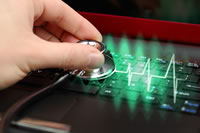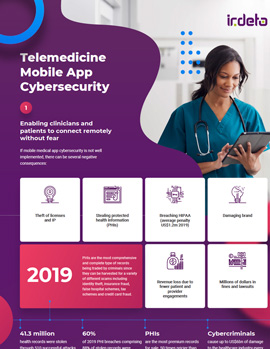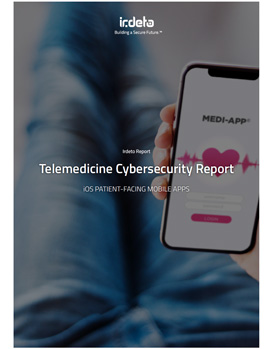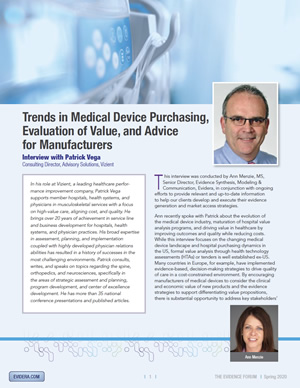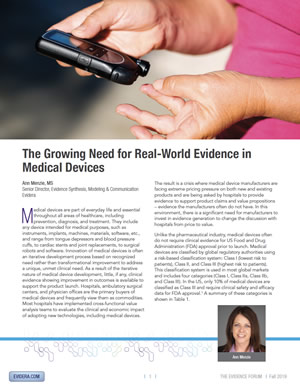|
Product Development
By Maria Fontanazza, Editor-in-Chief A Q&A with MedCrypt’s Axel Wirth sheds light on urgent problems that the medtech industry is facing regarding device security, but assures us that the sky is not falling. |
|
SPONSORED CONTENT |
|
Selecting the right material for your medical device can be a challenge. First, learn several traits of injection molded materials and how these will reflect in your medical device application, for example, hardness, flexibility, chemical resistance, cost, etc. Once you know the traits your medical device requires, you can review the different materials to fit your application. Review this information to make the best material selection for your medical component or device. |
| Featured Articles |
|
Business Analysis
By Kyle Forcier, Model N Leveraging automation and data analytics can help facilitate innovation and financial stability. |
|
Product Development & Market Access
By MedTech Intelligence Staff Combining “fit, filtration and efficiency” is the key to enhancing protection and encouraging compliance. |
|
SPONSORED CONTENT |
|
September 22 - 23, 2020 | Webcast This Conference identifies current risks and responsibilities arising as devices age and is focus on need for a collaborative approach among manufacturers, hospitals, and regulatory bodies to successfully address connected device security issues. What you will learn:
|
|
Business Trends & Analysis
By MedTech Intelligence Staff Although the full impact of COVID-19 is uncertain, one sure thing is that industry continues to crave information to help them navigate EU MDR. |
|
Market Access
By Greg Kahn, Internet of Things Consortium With everything to gain, telehealth may lead to a new standard in health/wellness treatment while at the same time unifying the entire healthcare ecosystem. |
|
SPONSORED CONTENT |
|
September 16, 2020 | Webcast Even companies that are successfully managing other aspects of EU MDR still wrestle with the challenges of software. Most software currently in Class I will be upclassified, requiring the establishment of a certified quality system and notified body involvement. There is confusion about current and evolving device and system standards and guidances and their relationship to the new regulatory requirements, and significant ambiguity about emerging technologies, cybersecurity, data privacy, interoperability, and risk management. |
|
Market Access
By James Archetto, Gaumard Scientific During the current operating environment there has been an increased need for healthcare training using patient simulators for students and practicing healthcare professionals. |
|
Featured Quote — Maaike Op de Beeck, Ph.D., imec |
|
| MedTech Library |
|
Sponsored By Irdeto If mobile medical app cybersecurity is not well implemented, there can be several negative consequences. How can you protect your mobile medical application from hackers? Download the infographic to learn more. |
|
Sponsored By Irdeto In this white paper, Irdeto identified five popular patient-facing iOS telemedicine mobile apps that offer on-demand virtual visits direct to customers through the App Store and performed an extensive cybersecurity threat risk analysis of these apps. |
|
Sponsored By 3M “Doctor’s orders” used to be the be-all, end-all. Today, it’s common for patients to seek multiple opinions, highly-tailored treatment options and ways to monitor their health themselves. Wearable medical devices have been game-changers – especially for people with chronic illnesses. Wearables enable patients to have constant access to health data that allows them to make critical health decisions from the comfort of their own homes or on-the-go. |
|
Sponsored By Evidera Gone are the days of selling med tech products to surgeons and physicians based on relationships alone. Today, surgeons must convince hospitals that a new product provides clinical and economic value, and manufacturers must arm surgeons with evidence to facilitate successful discussions with hospital value-analysis teams (VAT). |
|
Sponsored By Evidera Derived from a wide range of data sources, real-world evidence (RWE) is used to complement clinical trial data to create a robust evidence base showing both safety and efficacy in defined populations (clinical trials), as well as outcomes in the general populations. |
|
| Upcoming Events & Webinars |
|
| Resource Centers |
|
Resource Centers are single topic focused micro-sites within MedTechIntelligence.com that are portals of information on medical device components and quality systems offering news, articles, white papers, case histories and videos. |
|









